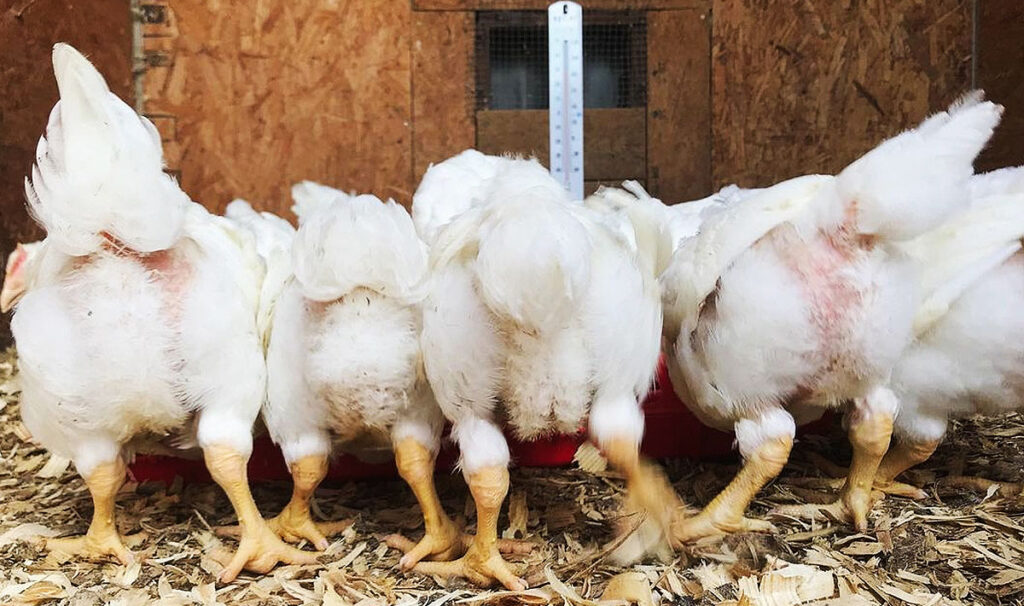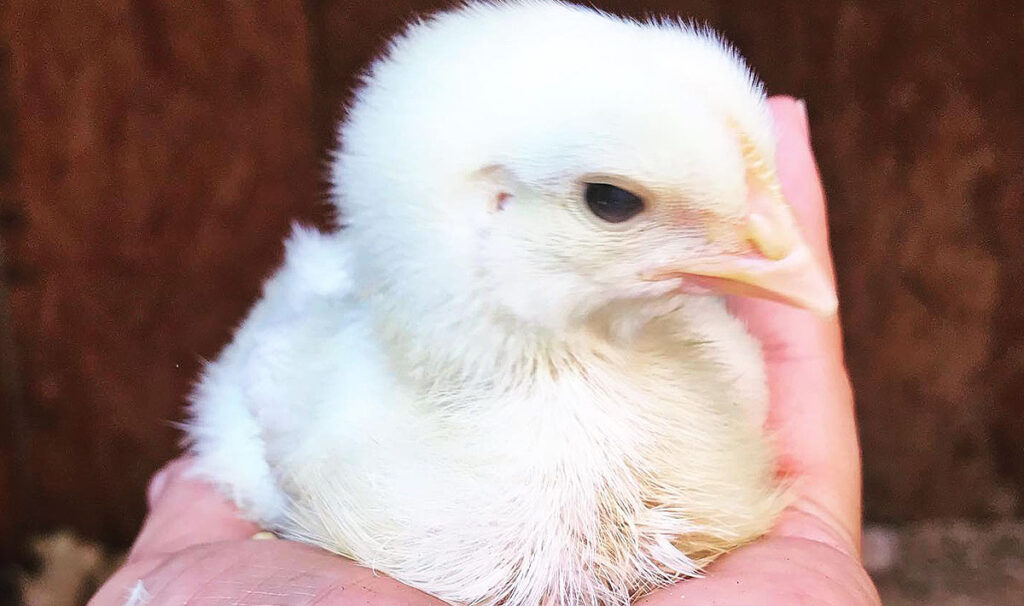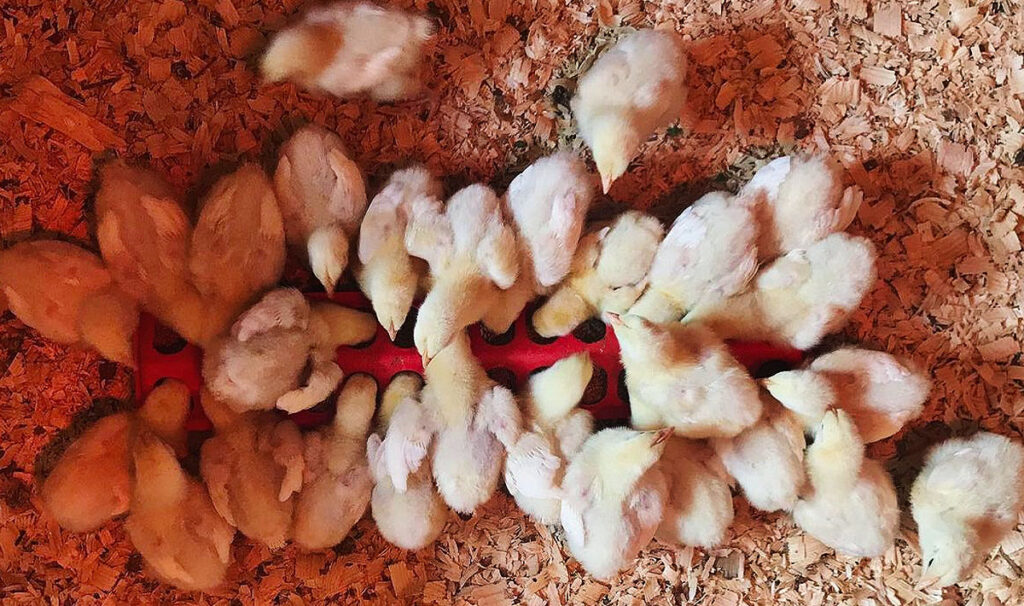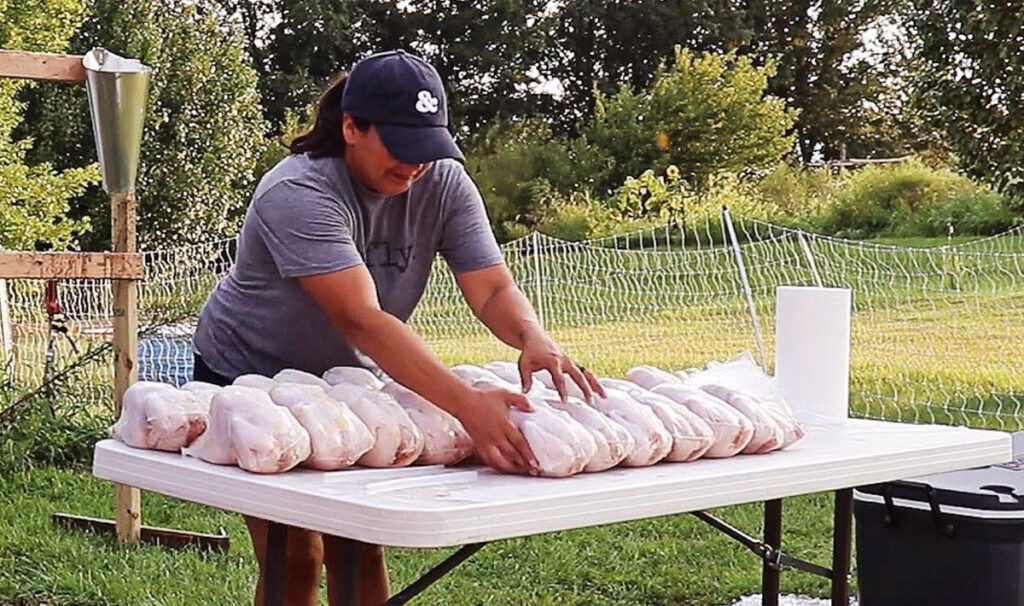Getting Started with Cornish Cross Chickens
Today let’s talk about raising your own chicken for meat. I’m going to cover the entire 8-10 week period that includes bringing your chicks home on day one, setting up a brooder, what kind of feed you’ll need throughout that whole period, the infrastructure you’ll need, moving them out to grass, and final processing. That’s a lot to cover, so let’s get started.
Before we start, I also put together a weekly video series on raising Cornish cross chickens for meat. It follows the entire process from bringing home the day old chicks, setting up the brooder, moving them to grass, and on. If you’d like to check it out you can follow me on YouTube.
First let me start by saying that raising animals for food is no small task and brings with it a huge responsibility. Growing up in the city I never imagined I’d be raising my own chicken to put on the table. But now that I’ve done this for a few years there’s no more humbling and fulfilling experience than being able to feed my family with food I raised right here on our farm. If you find yourself at the beginning of this process, I hope this serves as reassurance that you are more than capable. If at any point you have questions, post them in the comments below, and I’ll answer them to the best of my ability.
The Cornish Cross Breed

Cornish cross chickens are unlike other chickens. They’ve been specifically bred for high meat yield, rapid growth, and are efficient feeders. Because of this breeding it’s almost impossible to hatch your own chicks for a sustainable food source. Right now we don’t have the capacity to hatch our own chickens for meat, so I gladly support local and reputable hatcheries that can provide quality Cornish cross chickens.
Where to Buy Cornish Cross Chickens

There are a number of hatcheries across the U.S. where you can source your chicks. I live in Missouri and prefer to stay as local as possible so I buy my Cornish cross chicks from Cackle Hatchery in Lebanon MO. They’re only a couple of hours away, so it’s really convenient for me to just drive there and back to reduce the travel stress the chicks will experience early on.
If you don’t have a trusted local hatchery or don’t live in Missouri, I’ve recently picked up egg laying chicks from McMurray Hatchery in Iowa. They have a convenient online ordering system and great customer service. The chicks are doing quite well and seem to have handled the stress of a 6-hour drive without issue.
This isn’t an endorsement for either hatchery. They just happen to be the two hatcheries I have experience with that also have great reputations.
Brooder Setup
The most important thing to remember with the Cornish Cross breed is that they need plenty of space. Due to their early and rapid growth, they can quickly outgrow a small brooder. Beyond that, setup is similar to any other breed. The brooder should have plenty of airflow and be easily heated until the chicks are sufficiently feathered out. Your chicks will utilize this space for the first 3 to 4 weeks.
A sturdy box or tub will work as long as there’s sufficient air flow. On our farm, I converted an old insulated dog shed that works well for the 30+ chicks I order every year. I also love that it’s easy to clean and has ample headroom for me. However, I’ve also used large storage containers and even the bathtub in our little-used basement bathroom. My husband, Matt, hated the bathtub brooder so I’m definitely not doing that again.
What to Feed Cornish Cross Chicks

Cornish cross chickens require a high-protein diet to grow properly. In the early weeks, while still in the brooder, a starter crumble or mash with 20-22% protein is ideal. I personally use non-medicated starter/grower crumble with 20% protein from day one until the move to grass.
Once the chicks have completely feathered out and ready for grass, around 4 weeks, I switch to a finisher feed with 14-16% protein and put them on a stricter feeding schedule. Up to this point, the chicks have had free access to food and water all day and night.
Speaking of water…on day one, when you bring your chicks home from the hatchery or post office, I recommended adding honey or electrolytes to their water to give them a quick energy boost after the stress of traveling. I like to use honey specifically because it’s loaded with vitamins and antioxidants to give my chicks the best start possible. I continue to use honey for the first 1-2 days.
Optional:
Around 3-4 weeks, before the move to grass, you can switch to a grower feed with 16-18% protein. and then a finisher feed at around 14-16%.
Cornish Cross Growth and Care

Because Cornish cross chickens grow rapidly they’re prone to leg and joint issues, and heart problems. Giving the chickens adequate space, a balanced diet, and clean living environment can help prevent many of these issues.
Note: Just like other chicken breeds, Cornish cross males will generally be bigger and grow faster. Keep this in mind, because if you have a mixed-gender flock, it can give the illusion of inconsistent growth. You should be able to tell quickly which ones are male. If you want consistent finished weights, certain hatcheries will let you order all male or all female birds.
Feeding Schedule for Cornish Cross Chickens
Cornish cross are notorious for their voracious appetites that can lead to growth and leg issues. For that reason I have a strict feeding schedule that helps keep the chickens healthy and controls their weight gain.
I like to call it the 12-On/12-Off method which means the birds have 12-hour access to feed followed by 12 hours with no feed. I start this feed schedule at week 4 or 5, whenever the chickens move outside and on to grass.
| 7:00 a.m. – 7:00 p.m. | 7:00 p.m. – 7:00 a.m. |
|---|---|
| Access to food and water | Remove access to food and water |
I should clarify that during the 12-On period I’m not out there checking the feeders constantly. I’m a working mom so I make sure the feeders are as full as can be at 7:00 a.m. before I leave for work. And as soon as I get home I go back out and refill the feeders. This has worked really for me.
Housing and Space for the Move to Grass

I’ve already touched on the brooder setup so let’s talk about outdoor setups. Once your Cornish cross have fully feathered out, around 4 weeks old, they’re ready to go outside on grass.
The most common type of housing for pasture raised Cornish cross chickens is a mobile or portable chicken coop known as a chicken tractor. A chicken tractor is a lightweight structure that can be moved easily, allowing the chickens to have access to fresh pasture or grass regularly.
Some key features of a typical chicken tractor are mobility, predator proofing, shelter from the elements, feeder and waterer integration, and ample space for the flock size.
The most common mobile chicken structures are the Joel Salatin box-style and the John Suscovich A-frame. There are some notable homesteaders with chicken tractor plans, but when it comes to raising Cornish cross chickens for meat, I believe these two are the best.
Health and Hygiene

Cornish cross chickens are notorious for health issues. A lot of that can be attributed to poor hygiene and improper feeding. I’ve been able to avoid many of these issues because I pay attention to my flock’s needs. Here are some tips to help you maintain good hygiene:
- Change bedding regularly while they’re still in the brooder.
- Provide fresh water and feed.
- Provide access to fresh grass regularly.
- Ensure the shelter has ample space for proper airflow and movement.
- Look for signs of illness or distress, such as lethargy, loss of appetite, or abnormal behavior. Chickens that display any of these characteristics should be immediately separated from the rest of the healthy flock.
- Implement biosecurity measures to prevent the introduction and spread of diseases.
When Cornish Cross Chickens Are Ready to Butcher

Cornish Cross chickens typically reach butcher weight between 8 and 10 weeks of age. In some cases, they can be ready to harvest as early as 6 weeks. The timeframe will really depend on how big you want your birds to be. I like to target a weight of 7.5-8 lbs to have fully dressed chicken at 4-6 lbs. I start weighing my birds at the 6 week mark to make sure I’m on track. This also gives me time to tweak their feed schedule to ensure my chickens will be ready by a certain timeframe.
If you’re not doing the processing yourself, this will also give you ample time to schedule it with a local facility. However, the earlier you can book the date the better.
Processing Cornish Cross for the Freezer

Preparation is the key to a successful and efficient processing day (or days) and that starts with your supplies.
Gather your supplies:
- Sharp knives
- Cutting board
- Clean, sanitized work area
- Large pots for scalding and chilling
- Some type of heat source to bring your scalding water up to temperature (we’ve used a gas turkey fryer with decent success)
- Plucking equipment (if not using a mechanical plucker)
- Gutting tools (e.g., poultry shears, gutting knife)
- Clean, food-safe containers or plastic bags for packaging
- Ice or cool water for chilling
- Cooler that can fit all of your chickens
- Canopy tent (if processing outside)
Set up your processing station:
- with access water to keep the work area clean and sanitized.
- separete water sources for the scalder and evisceration station. I recommend a 2-way hose splitter with separate hoses running to each.
- for maximum efficiency and safety in mind.
I’m going to stop right here because this blog entry is already quite lengthy. Look for a follow up post soon on how we process our birds and how we setup the processing station for maximum efficiency. In the meantime, I have a video on how we do this if you’d like to check that out.
It’s Week 9 and Finally Time to Process Our Cornish Cross Chickens ![]()
Closing
I know that’s a lot to cover but I remember having so many questions about raising Cornish cross chickens over the 8-10 week period. It was difficult to find reliable sources and I had to piecemeal a lot of it. So I created this list to help the first time meat bird farmer be better prepared.
There really are few things more fulfilling yet humbling like raising an animal for the sole purpose of feeding your family. Remember, if a city girl like me with no farming experience can do this, so can you. I’ll be here cheering you on.
Adios 👋🏼



